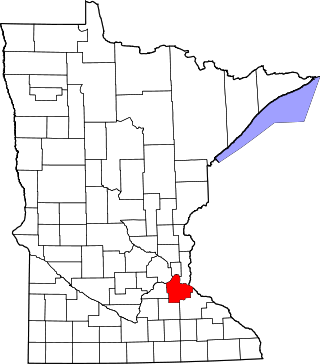
Scott County is a county in the U.S. state of Minnesota. As of the 2020 census, the population was 150,928. Its county seat is Shakopee. Shakopee is also the largest city in Scott County, the twenty-third-largest city in Minnesota, and the sixteenth-largest Twin Cities suburb. The county was organized in 1853 and named in honor of General Winfield Scott. Scott County is part of the Minneapolis-St. Paul-Bloomington, MN-WI Metropolitan Statistical Area. It is a member of the Metropolitan Council, and shares many of the council's concerns about responsible growth management, advocating for progressive development concepts such as clustering, open-space design, and the preservation of open space and rural/agricultural land.

Le Sueur County is a county located in the south central portion of the U.S. state of Minnesota. As of the 2020 census, the population was 28,674. Its county seat is Le Center.

Dakota County is the third-most populous county in the U.S. state of Minnesota, located in the east central portion of the state. As of the 2020 census, the population was 439,882. The population of Dakota County was estimated to be 443,341 in 2022. The county seat is Hastings. Dakota County is named for the Dakota Sioux tribal bands who inhabited the area.

The Territory of Minnesota was an organized incorporated territory of the United States that existed from March 3, 1849, until May 11, 1858, when the eastern portion of the territory was admitted to the Union as the State of Minnesota and the western portion became unorganized territory and shortly after was reorganized as part of the Dakota Territory.

The Lower Sioux Agency, or Redwood Agency, was the federal administrative center for the Lower Sioux Indian Reservation in what became Redwood County, Minnesota, United States. It was the site of the Battle of Lower Sioux Agency on August 18, 1862, the first organized battle of the Dakota War of 1862.

This is a list of sites in Minnesota which are included in the National Register of Historic Places. There are more than 1,700 properties and historic districts listed on the NRHP; each of Minnesota's 87 counties has at least 2 listings. Twenty-two sites are also National Historic Landmarks.

Minnesota State Highway 149 (MN 149) is a 9.924-mile-long (15.971 km) highway in Minnesota that runs from its intersection with State Highway 3 in Inver Grove Heights to its northern terminus at its intersection with State Highway 5 in Saint Paul.

Minnesota State Highway 49 was a state highway in Minnesota. It originally followed Rice Street from downtown St. Paul into the northern suburbs of the Twin Cities, shifting a northern termini between Interstate 35W and also the Lino Lakes Correctional Facility. In the late 1990s, the route was cut back to end at Interstate 694 in Shoreview and then fully removed shortly after. Guide signs at the County Road 23 exit from Interstate 35W in Lino Lakes were marked as "OLD 49" for five years after the removal, however these signs were removed around 2003.

Winona station, formerly known as the Chicago. Milwaukee & St. Paul Railway Station, is a historic train station in Winona, Minnesota, United States. It is served by Amtrak's daily Empire Builder service. It was originally built in 1888 by the Chicago, Milwaukee, St. Paul and Pacific Railroad, known later as the Milwaukee Road. A former Milwaukee Road freight house also exists here.
The River to River Greenway is a paved multi-use trail in development in Dakota County, Minnesota, United States. Phase II, completed in October 2007, is a 1.3-mile (2.1 km) segment that parallels Minnesota State Highway 110 from Charlton Street to Dodd Road.

This is a list of the National Register of Historic Places listings in Dakota County, Minnesota. It is intended to be a complete list of the properties and districts on the National Register of Historic Places in Dakota County, Minnesota, United States. Dakota County is located in the southeastern part of the U.S. state of Minnesota, bounded on the northeast side by the Upper Mississippi River and on the northwest by the Minnesota River. The locations of National Register properties and districts for which the latitude and longitude coordinates are included below, may be seen in an online map.

The Church of St. Wenceslaus is a Catholic church in New Prague, Minnesota, United States, constructed in 1907. The church is flanked by a 1908 rectory and a 1914 parochial school, and the three-building complex is listed on the National Register of Historic Places for its association with the Czech American settlement of south-central Minnesota.

This is a list of the National Register of Historic Places listings in Rice County, Minnesota. It is intended to be a complete list of the properties and districts on the National Register of Historic Places in Rice County, Minnesota, United States. The locations of National Register properties and districts for which the latitude and longitude coordinates are included below, may be seen in an online map.

This is a list of the National Register of Historic Places listings in Le Sueur County, Minnesota. It is intended to be a complete list of the properties and districts on the National Register of Historic Places in Le Sueur County, Minnesota, United States. The locations of National Register properties and districts for which the latitude and longitude coordinates are included below, may be seen in an online map.

This is a list of the National Register of Historic Places listings in Cass County, Minnesota. It is intended to be a complete list of the properties and districts on the National Register of Historic Places in Cass County, Minnesota, United States. The locations of National Register properties and districts for which the latitude and longitude coordinates are included below, may be seen in an online map.

This is a list of the National Register of Historic Places listings in Faribault County, Minnesota. This is intended to be a complete list of the properties and districts on the National Register of Historic Places in Faribault County, Minnesota, United States. The locations of National Register properties and districts for which the latitude and longitude coordinates are included below, may be seen in an online map.

The Point Douglas–St. Louis River Road Bridge, built in 1865, is the second oldest known stone arch bridge in the state of Minnesota after Sibley's Ferry Bridge in Mendota, which was built in 1864. It was constructed in Stillwater Township to carry the Point Douglas to Superior Military Road over Brown's Creek. The bridge was listed on the National Register of Historic Places in 1975 for having local significance in the themes of engineering and transportation. It was nominated as an example of stone engineering and as a remnant of Minnesota's early government roads.
The Ridge Trail Historic District near Kensington, North Dakota is a 47.7-acre (19.3 ha) historic district encompassing portions of the first major settler trail through Walsh and Pembina Counties. It includes 8 segments of a rutted cart trail that was used to move people and supplies into the area from as far off as St. Paul, Minnesota.

The Mendota to Wabasha Military Road, Cannon River Section is a 3,200-foot-long (980 m) fragment of a road in Red Wing in the U.S. state of Minnesota. The road once stretched from Mendota to Wabasha and was planned in the earliest years of Minnesota Territory before Minnesota became a state. This particular fragment of road, which spans the Cannon River bottomlands, was listed on the National Register of Historic Places in 1991. It was listed as part of a statewide survey that identified historic fragments of the military wagon roads built between 1850 and 1861. The survey found that a road fragment could be considered historic if it was unpaved, that it is "long enough to evoke a sense of destination" where an observer at one end could not see the other end, and that the setting of the road had not been intruded upon with recent buildings or roads.

Oheyawahi-Pilot Knob is a scenic overlook, and a Native American gathering place and burial ground in Mendota Heights, Minnesota, United States. The overlook provides views of the confluence of the Minnesota and Mississippi Rivers, Fort Snelling, and the Minneapolis and St. Paul skylines. It was the site of the 1851 Treaty of Mendota between the United States federal government and the Dakota people of Minnesota, who consider the site sacred. In 2017, Oheyawahi-Pilot Knob was listed on the National Register of Historic Places.





















